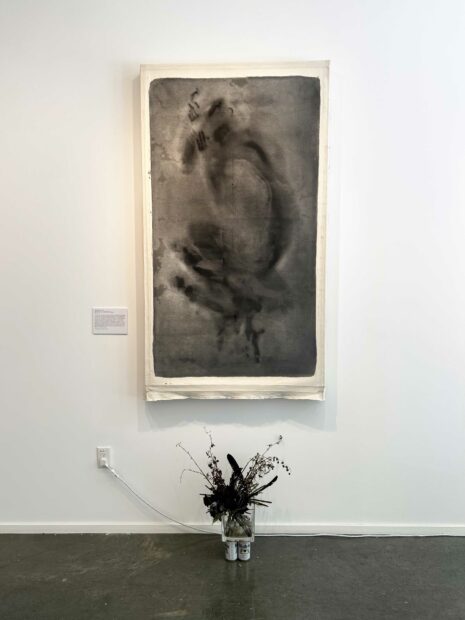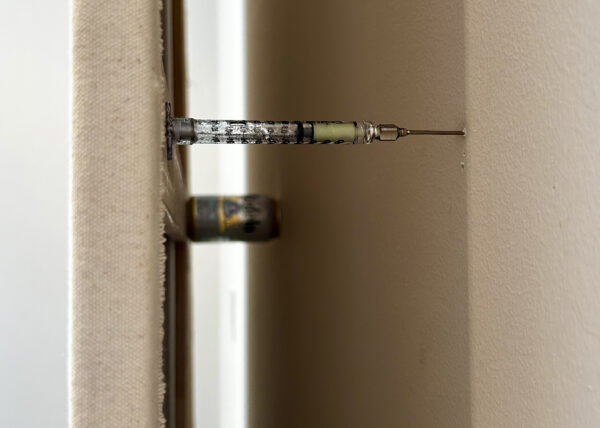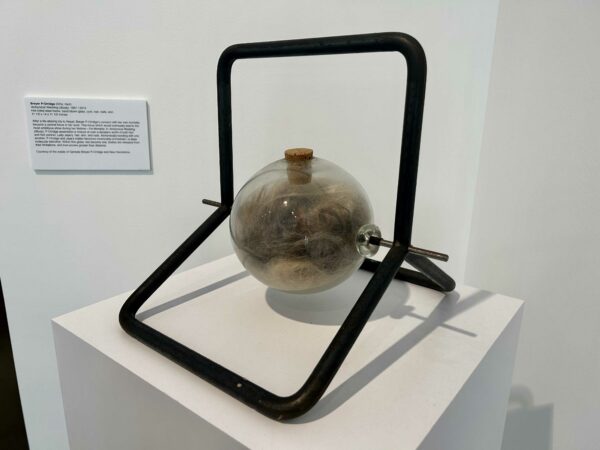Our understanding of our identity is informed by an array of factors, but arguably the most influential is that of our physical bodies. The nature of our bodies and the subsequent intersections between physical form, gender, race, and sexuality are as infinite as the unique experiences of each individual person. The current exhibition at the Green Family Art Foundation, Full And Pure: Body, Materiality, Gender, dives into those very topics. Curated by Mara Hassan, the show comprises the work of nearly 40 artists, ranging from painting, photography, and video to sculpture, installation, and poetry.

Left to right: Christina Quarles, “A Head of Ourselves (Lez We Get),” 2020, acrylic on canvas; Ilana Savdie, “A wavering wound lies (about longing),” 2022, oil, acrylic, and beeswax on canvas stretched on panel.
When entering the gallery, you are greeted with many brightly colored works on canvas. Devan Shimoyama’s dazzling self-portrait, embellished with his signature sequins and glitter, is hard to miss and never falls short of iconic. In a painting by Christina Quarles, semi-abstract bodies tangle together in what could be an impassioned dance or a fiery scuffle. Next to it, abstraction entirely dissolves the figurative into a composition of playful neon colors by Ilana Savdie. Already, the show exudes a sense of playfulness, but as I ventured further back into the gallery the pieces slowly grew increasingly intimate.

Ren Light Pan, “sleep painting–02.14.15, Irvine, CA,” 2015, water, 98.6 F (37 C), loneliness, and ink on canvas.
Some of the first works that really caught my eye were two large, dark canvases facing each other. The pieces were completed nearly seven years apart by Chinese-American artist Ren Light Pan. In sleep painting–02.14.15, Irvine, CA, the imprint of Pan’s sleeping body, curled up motionless, captures a time in her life of immense sadness and pain. When reading the wall label, I was struck by one of the materials listed: loneliness. Pan’s second piece, completed seven years later, sleep painting (RETURN, REBORN)–11.01.21, New York, NY, holds a completely different air. Although the canvases appear similar, the composition is much less recognizable as a human form. This work was completed after Pan transitioned, and it is full of movement and new life. Holding up this canvas from behind were empty beer cans and used syringes, presumably from hormone therapy injections.

Detail of Ren Light Pan, “sleep painting (RETURN, REBORN)–11.01.21, New York, NY,” 2021, water, 98.6 F (37 C), transgirl, and ink on canvas; syringes, photoluminescent pigment.
The hazy and eerie impressions on the canvas border on printmaking or performance art, reminding me of David Hammons’ iconic body prints. Just like Hammons, Pan uses her body to create the artwork (the body as material), while the work itself asserts a narrative about the body, in this case about her body and her lived experience as a trans woman. The two canvases hanging across from one another present a vulnerable conversation about the gendered embodiment and transitions, both somatically and mentally.

Breyer P-Orridge, “Alchymical Wedding (Study),” 1997-2012, hot-rolled steel frame, hand blown glass, cork, hair, nails, skin.
Although many of the works within the exhibition directly depict the human body, there are a few pieces that depart from over representation. Bits of text by the late multimedia artist and writer Mark Aguhar are sporadically placed on the walls throughout the gallery, snaking around corners below or above eye level, so out of the way that I almost missed some of the poems entirely.
Similarly, a sculpture titled Alchymical Wedding (Study) by cult rock musician and body modification pioneer Breyer P-Orridge depicts a large round-bottom flask filled with strands of hair and bits of nails and skin from P-Orridge and their partner, Lady Jaye, which they collected over the course of a decade. Although the materials may strike one as unsettling, the act of merging the two lovers together on an atomic level is a rather romantic gesture, defying the limitations of biology. Although both the artist and their partner have since passed away, this piece remains as a deeply personal and symbolic token of their love and life together.

Left to right: Puppies Puppies (Jade Guanaro Kuriki-Olivo), “Eve’s/Adam’s Apple (Adam’s Apple is a lump of cartilage that sticks out from the throat) (clocked by my large Eve’s/Adam’s Apple) (Eve’s Apple) (not bitten – pre-banishment),” 2020, unbitten apple; “Eve’s/Adam’s Apple (Adam’s Apple is a lump of cartilage that sticks out from the throat) (symbol of banishment) (clocked by my large Eve’s/Adam’s Apple) (Eve’s Apple) (Bitten),” 2020, bitten apple.
But my favorite artwork was the most unassuming. Jade Guanaro Kuriki-Olivo, aka Puppies Puppies, is a conceptual and performance artist who is well known for her ability to transform common objects into meaningful readymades. The work on view, Eve’s/Adam’s Apple, consists of two apples placed in opposite corners of the gallery. One apple is left whole, while the other has been bitten into. The installation references the gender-affirming surgery known as a tracheal shave, or chondrolaryngoplasty, which is a procedure that reduces the size of one’s Adam’s apple. Meanwhile, the title of the work alludes to the biblical characters of Adam and Eve and the story of original sin: eating the forbidden fruit. Although this work may seem too simple to be impressive (such is the history of readymades or conceptual art in general), I cannot help being taken with how a common food with a single bite has the ability to encompass such a personal narrative surrounding the body, gender, and the transgender experience.
Full And Pure: Body, Materiality, Gender is curated by Mara Hassan and is on view at the Green Family Art Foundation (2111 Flora Street, Suite 110, Dallas, TX 75201) through September 24, 2023.
Emma S. Ahmad is an art historian and writer based in Dallas, TX.




1 comment
Your perspective brings a lot of clarity and appreciation to these pieces. Also, thank you for the info at the Nasher. I love the passion you have for art and hope to read more articles from you in the future.